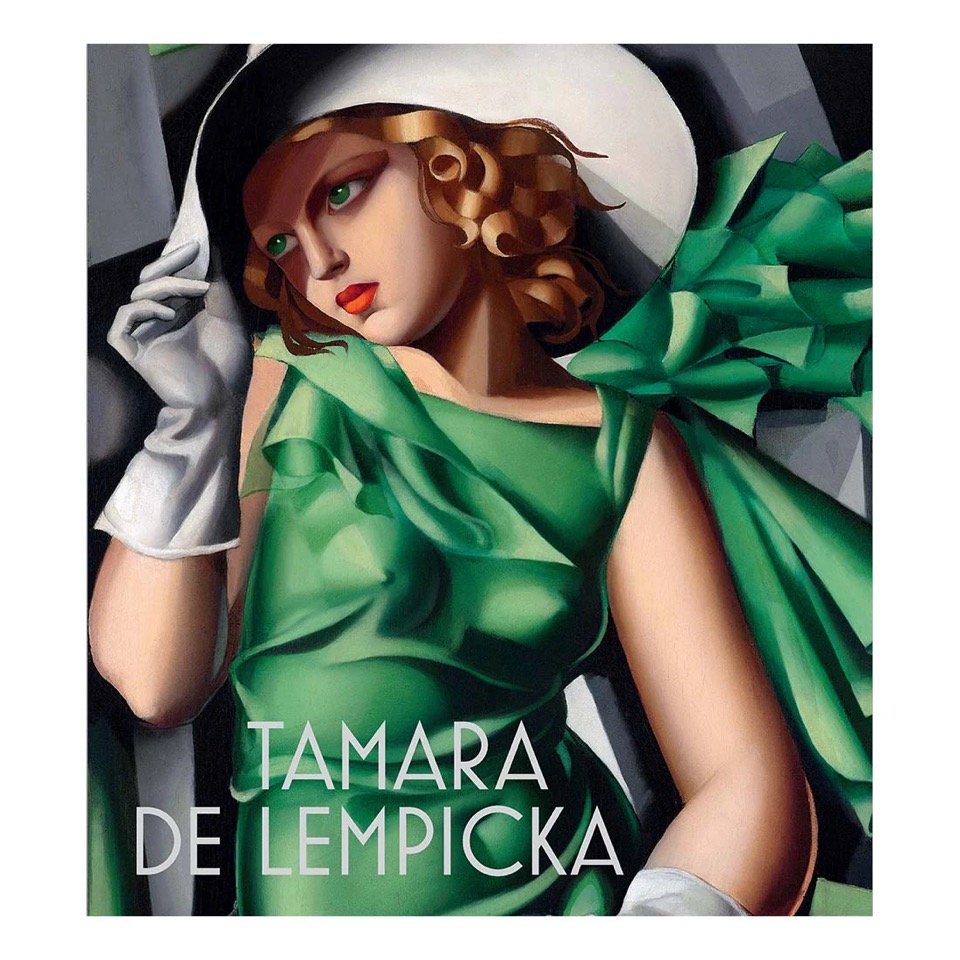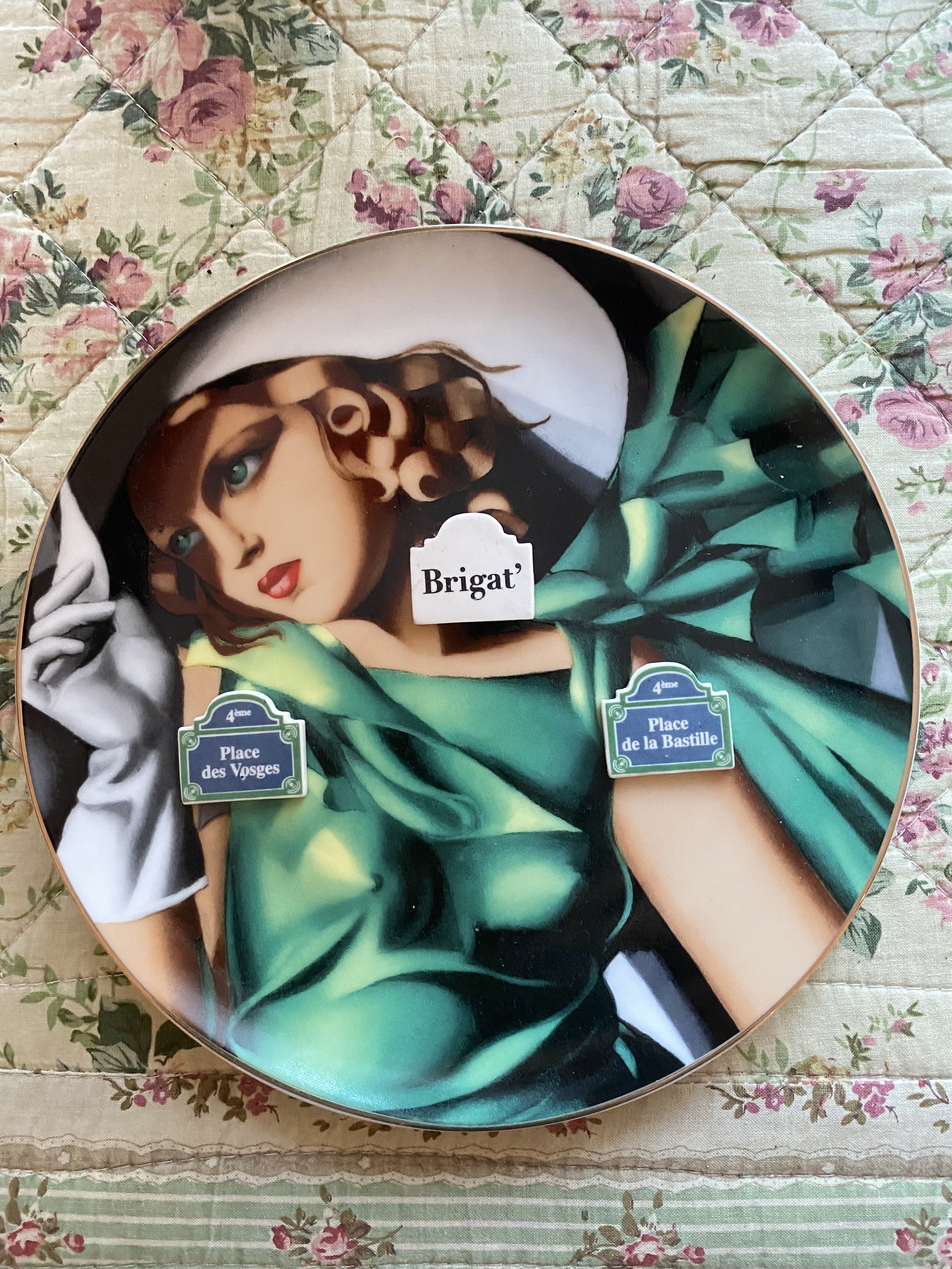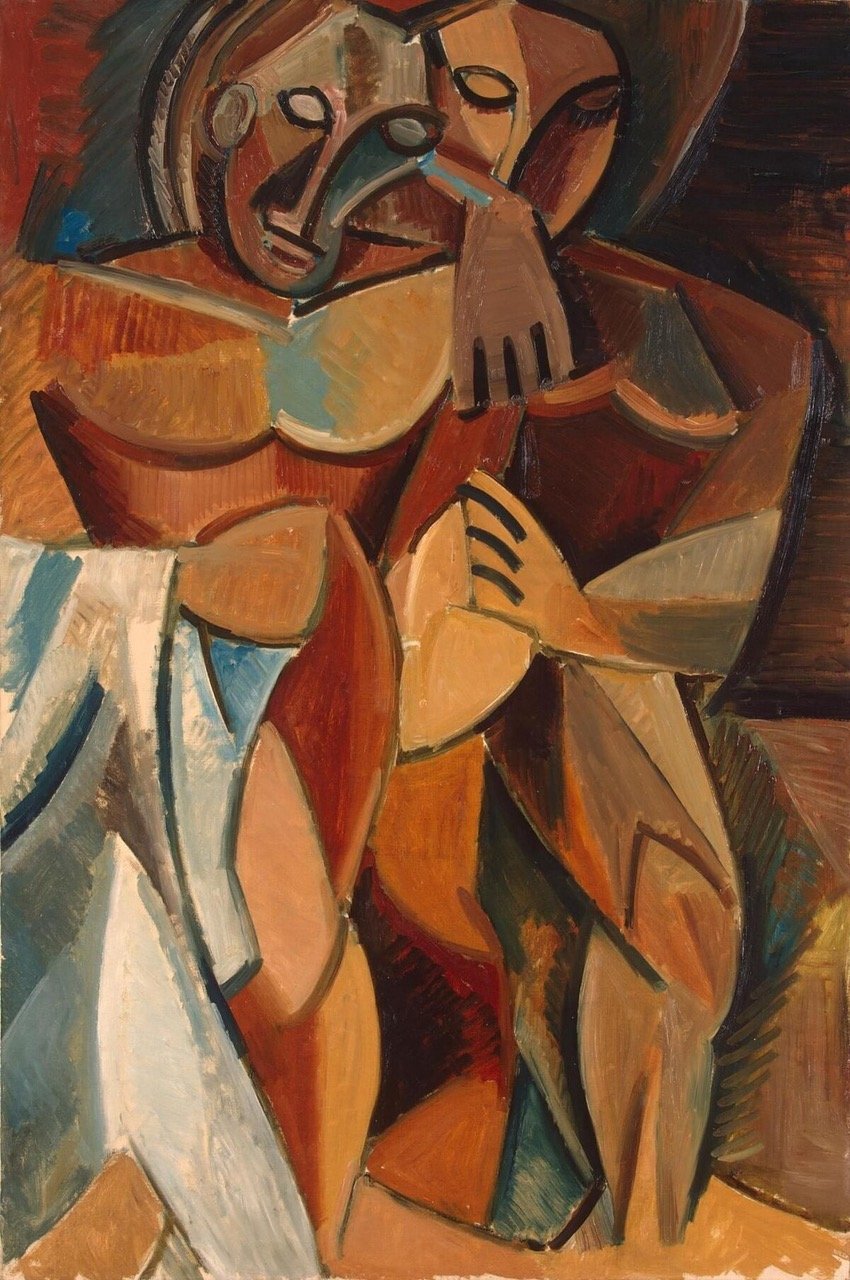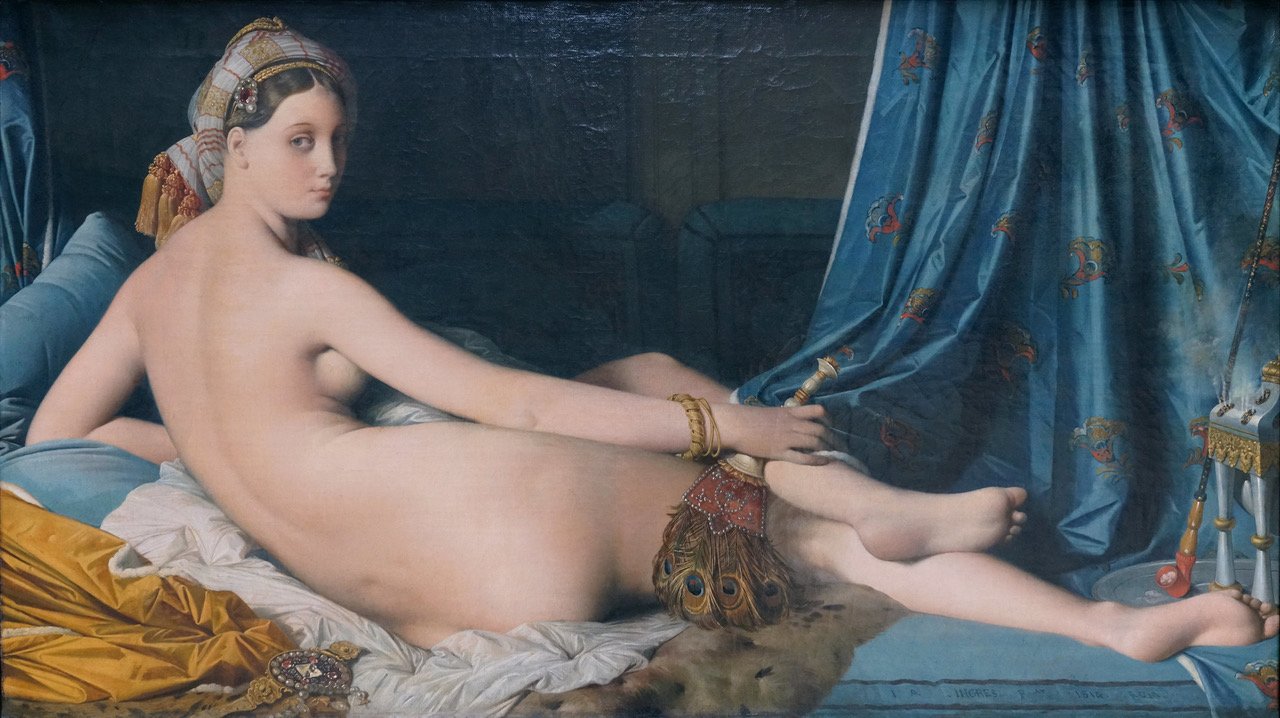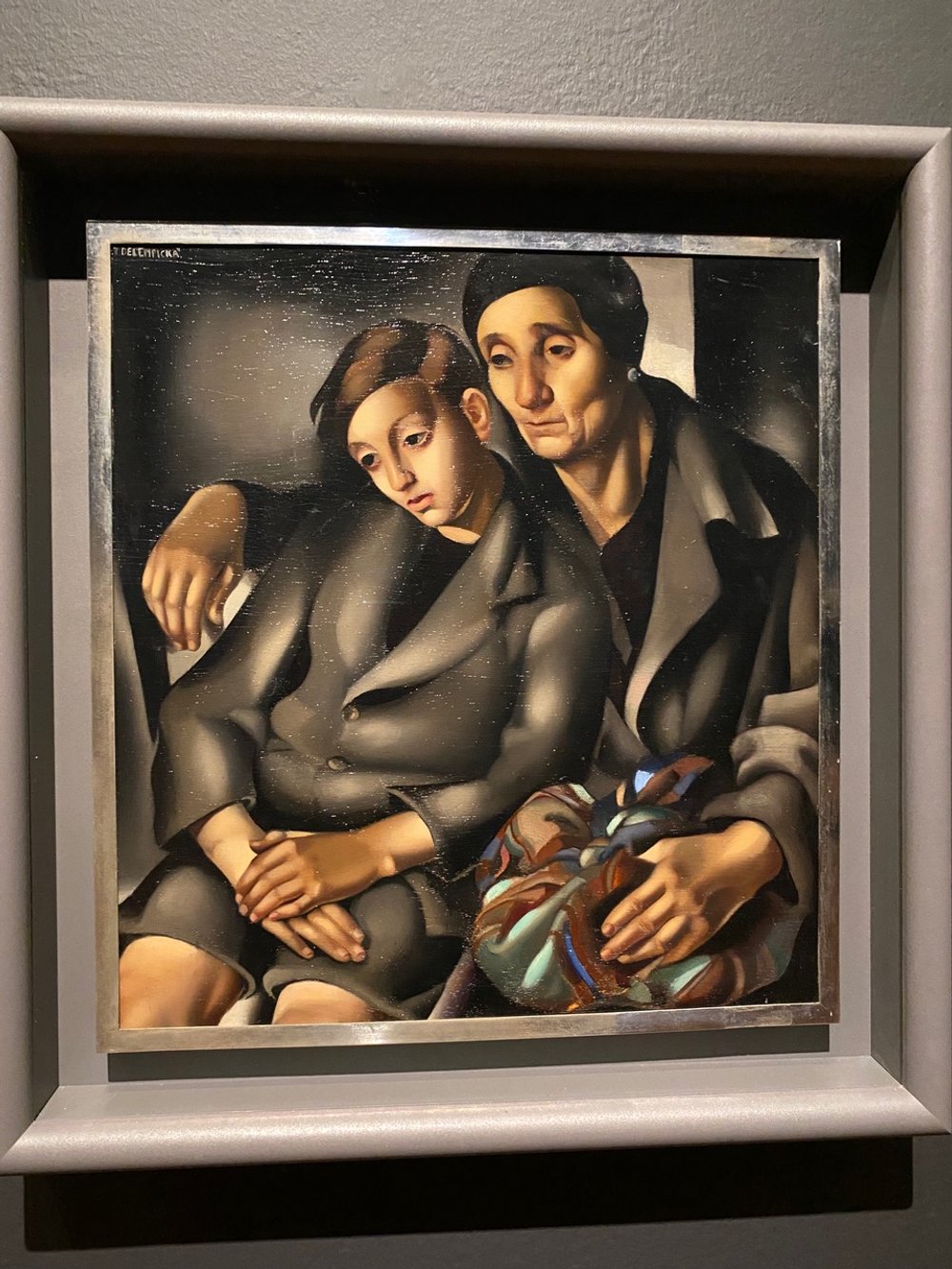Auto Eroticism: Girls in Cars, Driving Fast
Bienvenue and welcome back to Musée Musings, your idiosyncratic guide to Paris and art. I’m finally back in Paris and I’m ready to get back to art. But first, a review of what brought me back to Paris in January when the weather is epouvantable (terrible). Galettes des rois bien sur. I was planning to try Alain Ducasse’s galette since this is the first year he has offered them. But they were only available whole for 42€. I wasn’t planning a jet-lag party and I wasn’t up for eating an entire galette on my own. Luckily, my two favorite nearby boulangeries, Miemie and Brigat were selling galettes by the slice. The classic version from Miemie had a wonderful thick layer of frangipane, made with unpeeled almonds. The non-traditional filling of their second offering, chocolate and farine de sarrasin (buckwheat flour) was delicious, too. (Fig 1)
Figure 1. Galette des rois, Miemie
Brigat’s classic galette was excellent and the frangipane was just as thick as Miemie’s, and perhaps a bit more raffinée. Of the two non-traditional galettes created by the Colombo brothers (Brigat’s owners) this year, I chose the one with a frangipane. pecan cream and poached pear base with generous pieces of pecans and cubes of candied pear throughout. It was truly exceptional. Completely by chance, each of the two slices I got from Brigat had a feve. Both in the shape of a traditional Paris street sign. On one side was Brigat. On the other side of one is ‘Place de la Bastille,’ on the other, the street where the boutique is located - Rue de Pas de la Mule. (Figs 2, 3) I was back at Brigat on Thursday, the 30th to try another variation on the galette. This one, made with hazelnut paste and lemon cream, filled with morsels of candied lemon peel. Truly, it was the best of all the ones I tried this year. And don’t you know, I bit into another feve. This one had Place des Vosges on it. As I was telling Ginevra about it and bragging at my luck to have purchased 3 slices of galette and now have 3 feves, she suggested that surely must have been feves in all the slices. Maybe she’s right, but I still think I’m lucky to be here…
Figure 2. Galette des rois with pecans, Brigat
Figure 3. The feves from the three slices of galette des rois I bought at Brigat (on my Tamara plate!!)
Did anyone say art? I did! And I’m going to begin with the exhibition I saw last month in San Francisco. Tamara de Lempicka, born Tamara Rosa Hurwitz, probably in Warsaw, definitely into a Polish family of Jewish descent. A family that had already, prudently, converted to Catholicism. She grew up in Saint Petersburg and met her first husband there. His name was Tadeusz Lempicki. Tamara’s surname became the feminine declension of his - Lempicka. As the Russian Revolution got underway, Tamara and her young daughter got out of the way. They fled St. Petersburg for Paris where they waited for Tadeusz to get out of jail and join them (he was in prison because of his ties to the czar). While Tamara waited, she put a ‘de’ in front of her name which both classed it up and made it more French. And she took classes at the Académie de la Grande Chaumière where instructors taught painting and sculpture without imposing the strict rules of the Ecole des Beaux-Arts. Classes were cheap, tuition was pay as you go. (Figs 4, 5) Artists flocked there in winter for the same reason writers flocked to cafes, both were warmer than their apartments.
Figure 4. Tamara de Lempicka painting a portrait of her husband, Tadeusz Lempicki
Figure 5. The portrait Tamara was painting (above) By the time it was finished, Tadeusz had left Tamara. Perhaps Tamara left the left hand unfinished, the hand on which he would have worn his wedding ring
As you look at Tamara de Lempicka’s work, you will see that she blended Art Deco, which was her style with Cubism (Picasso, Braque), 16th-century Italian Mannerism, (Pontormo, Bronzino), 19th-century French Neoclassicism (Ingres), and Russian avant-garde (Kandinsky, Malevich). (Figs 6-10). She knew her art history..
Figure 6. Woman with Green Glove, Tamara de Lempicka
Figure 7. Friendship, Pablo Picasso
Figure 8. Visitation (meeting of Virgin Mary and Elizabeth, mother of John the Baptist) Pontormo
Figure 9. Portrait, Ingres
Figure 10. Figure, Malevich
Not long after Tamara got to Paris, the Années Folles got underway. These were years when lesbian and bisexual women lived openly without fear of censure or sanctions. Tamara fit right in. She was bisexual and although she married men, she seems to have loved women more. Her subjects were mostly sexualized women, clothed and nude, reworking themes that had been the domain of male artists and their male patrons since the Renaissance. Paintings originally intended for the heterosexual male gaze. Tamara simultaneously acknowledged and subverted the “patriarchal codes of the academic salons” with her paintings of women. (Fig 11)
Figure 11. Portrait of Ira Perrot, one of at least 8 painted by Tamara of her lover, Tamara de Lempicka
Tamara’s women were never “idealized odalisques, bathers, or heroines from Greek mythology or the Old Testament.” The backgrounds for her angular figures are modern and metropolitan, not classical or biblical. Walker Mimms (NYTimes) calls Tamara’s work ‘geometric realism,’ and ‘by turns, swaggering, Sapphic and sensational.” Looking to the Wizard of Oz for comparisons, Mimms suggests that Tamara “breathed jolts of humanity into her subjects, like the Tin Man’s achievement of a heart.” (Fig 12)
Figure 12. Tin Man getting an oiling by Dorothy, image from Wizard of Oz
The curators contend that Tamara showed women's bodies as “dominant and attentive to their own erotic pleasure.” That her nudes were “unabashed portrayal(s) of female sexuality, … realistic bodies represented through elementary forms, devoid of detail, following contemporary neoclassical and purist trends.” To me these bodies, with their smooth and angular forms, are sleek like machines rather than sexualized beings. To me, Tamara’s female bodies cry performance not pleasure. The vibe I get is Thierry Mugler not Titian or the Tin Man. (Figs 13, 14)
Figure 13. Fashion by Thierry Mugler
Figure 14. Sacred and Profane Love, Titian
Tamara once said without an ounce of false modesty, “Among a hundred paintings, you could always recognize mine.” She painted portraits for private clients and designed covers for popular women's magazines, like the Berlin based Die Dame, whose pages were filled with articles on fashion, literature and the arts.
‘St. Moritz’ (Fig 15) was painted in 1928, when this Swiss resort town hosted the Winter Olympics. Women had begun participating in the Olympics four years earlier, at the 1924 Paris games. To celebrate this increased involvement in competitive sports, Die Dame commissioned Tamara to paint a cover for its winter magazine. Tamara painted a close-up portrait of her long time lover, Ira Perrot, presumably just off the slopes, wearing a sweater by French fashion designer Jean Patou.
Figure 15. St. Moritz (portrait of Ira Perrot), Tamara de Pempicka
Young Girl in Green, (Fig 16) is, according to the curators of this exhibition, “an emblematic image of Art Deco, that encapsulates the optimism of the interwar period by paying tribute to the era's dynamic modern woman.” Dynamic and modern, yes, a celebration of women, I’m not convinced. Not when the description continues that the “anatomy (is) reduced to smooth geometric forms…conical breasts, curved hips, and deep navel… swathed in a green fabric … a kind of second skin.” It reminds me both of Michelangelo at his most Mannerist and the cylindrical cone bra designed by Jean Paul Gautier for Madonna’s 1990 Blond Ambition tour. (Figs 17, 18) According to Hilary Whiteman (CNN 2019) The bra “pink, pert and structured, oozed old-fashioned femininity. But on Madonna’s muscular body it also exuded authority and power.”
Figure 16. Young Girl in Green, Tamara de Lempicka
Figure 17. Entombment of Christ (unfinished) Michelangelo
Figure 18. Madonna dressed by Jean Paul Gaultier, 1980
La Bella Rafaela (Fig 19) depicts a nude woman absorbed, according to the curators, “in her own erotic pleasure,” although exactly how that self pleasuring is happening is not clear to this writer. The painting is executed from below, so maybe when the artist wasn’t painting she was occupied with the subject’s pleasure. Which may have been the case since this is a portrait of another of Tamara’s lovers, a sex worker named Rafaela who the artist met in the Bois de Boulogne, where sex workers still ply their trade. The curators suggest the following references - Ingres’ odalisques (especially the low angle), Courbet’s bacchantes and sleeping women and the dramatic lighting and limited color palette of Caravaggio. (Figs 20-22)
Figure 19. La Bella Rafaela, Tamara de Lempicka
Figure 20. Grand Odalisque, JAD Ingres
Figure 21. Bacchiante, Gustave Courbet
Figure 22. St Jerome in his study, Caravaggio
Woman with a Green Glove (Fig 6 above) is an unfinished portrait of an unidentified woman, whose hair is coiffed ‘à la garçonne,’ an androgynous style fashionable in the 1920s. The figure's pose (against a classical pedestal), and elegant outfit refer to her social status. Tamara is channeling 16th century Italian Mannerist portraits by artists like Bronzino, Parmigianino and Pontormo, whom she much admired. (Fig 23)
Figure 23. Portrait of a Young Man, Bronzino
“Deux Amies” (Fig 24) refers to a specific kind of friendship between women, a sexualized friendship. A friendship these two women, their limbs intertwined, obviously share. Tamara’s images of women are about the female gaze in general and the desiring gaze of one woman for another woman, in particular. Whether these bodies ‘read' as sensual or sexual, is a matter of personal taste. Their curves are generous, hard and stylized. Easy to see why Tamara is the singer Madonna’s favorite artist.
Figure 24. Deux Amies, Tamara de Lempicka
The lesbian singer Suzy Solidor, (Figs 25, 25a) was another of Lempicka’s models and lovers. She sang and acted and eventually became a symbol of female emancipation. Besides posing for Tamara - she posed for portraits by Picasso, Braque, Picabia, etc. .
Figure 25. Suzy Solidor, Tamara de Lempicka
Figure 25a. Me getting up close and personal with Suzy Solidor, the poster for the exhibition, Les Pionnieres at the Musée du Luxembourg, 2022
My favorite painting by Tamara is a self portrait at the wheel of a green Bugatti, (Fig 26) commissioned by Die Dame. Tamara never owned this car, but obviously, the small yellow Renault she drove at the time, would not have conveyed the wealth and status she was aiming for here. Female drivers were much less common in Tamara’s day than in our own. Cars were mostly driven driven by men or chauffeurs. By depicting herself at the wheel of a modern luxury car, she emancipates herself and offers Die Dame’s readers the same possibility. Reassuringly, dressing like a man wasn’t a prerequisite for driving like one.
Figure 26. Self portrait in a green Bugatti, Tamara de Lempicka
The curators relate this painting to Futurism, an art style that celebrated technology, industrialization and urban life. (Fig 27) When I first saw the painting, it reminded me of a commentary I heard years ago on the television show, Sunday Morning. The commentator’s topic was the preponderance of automobile advertisements featuring women alone in cars. The pitch was the same as the one Die Dame made a century earlier. Women don’t need men to buy cars, don’t need men to drive them. The commentator called the advertisements ‘Auto Eroticism.’ This self portrait seems the perfect distillation of that double entrendre.
Figure 27. Futurist Athlete, Guilio D’Anna
Sprinkled throughout the exhibition are portraits of Tamara’s daughter, Kizette. (Figs 28-30) Although the curators suggest that the overt Christian symbolism in some of the portraits was meant to distance her and her daughter from their Jewish roots, the paintings seem off, even creepy. When you read that Tamara told people that she had no children, that her daughter was her sister, the paintings seem even creepier.
Figure 28. Kizette, Tamara de Lempicka, 1927
Figure 29. Kizette, Tamara de Lempicka, 1929
Figure 30. Kizette taking Communion, Tamara de Lempicka
Tamara and Paris were a perfect fit until the Nazis showed up. Sure, her parents had converted to Catholicism before she was born, but she knew better than to wait around and hope for the best. So, with her new husband, Baron Raoul Kuffner, who was also Jewish, Tamara fled again, this time from France to the United States.
In the lead up to and during World War I (1939-1945), her subject matter changed from glamorous portraits of women enjoying their autonomy in modern cosmopolitan society, to somber, often religious paintings. (Figs 31, 32)
Figure 31. Mother Superior, Tamara de Lempicka
Figure 32. The Refugees, Tamara de Lempicka, 1937
Her painting, ‘Somewhere in Europe,’ (Fig 33) was her contribution to fundraising efforts for the British Red Cross. I remember thinking when I was looking at all of the prints of mothers and children at the Kathe Kollwitz museum in Berlin last year, (Fig 34, 35) that in a comparison of Cassatt and Kollwitz, Cassatt would look superficial. And even after the exhibition I saw on Cassatt’s works, I believe that is true. I couldn’t imagine that there could ever be anything that would unite Tamara with Kollwitz. And yet here it is, the anguish and fear in the mother’s face as she holds her child. Wondering how is she going to protect the baby and herself in the face of what awaits them. Tamara chose this painting as the poster for her 1941 exhibitions in New York, San Francisco, and Los Angeles. Although she had courted the American press, which nicknamed her the "baroness with a brush,” the exhibitions were not successful. Sensitive to criticism, Tamara gradually stopped exhibiting. One reviewer lamented that this exhibition focused on paintings from Tamara’s Paris years. I think it was a wise decision. Gros bisous, Dr. B.
Figure 33. Somewhere in Europe, Tamara de Lempicka, 1940
Figure 34. Mother with dead child, Kathe Kollwitz
Figure 35. The Hug, Mary Cassatt, 1880
Still Life with Seashells, 1941, Tamara de Lempicka, Tamara channeling her inner Georgia O’Keefe
Thanks to everyone who commented on last week’s post. I try to keep my posts unpolitical, but the words of Holocaust survivor Elie Wiesel are never far, reminding me to, "Always take sides. Neutrality helps the oppressor, never the victim. Silence encourages the tormentor, never the tormented.”
New comments on And So It Goes:
Lots of research went into this post, Beverly! Your uncomplimentary remarks about Trump crowd sizes were funny, but of course such comparisons have been common fodder for years. The takeaway point for me was your passage: “But whose money do you think rebuilt Notre Dame? And bought the Caillebotte painting ‘The Boating Party,’ for the Musée d’Orsay? That is the big difference I see between billionaires in France and those in the U.S. In France, they contribute financially to the cultural enrichment of the country, in the U.S. they buy access to power to get richer. Enhancing the cultural life of the U.S.A. is not part of the deal.” Note, though, that billionaire former Mayor of New York Michael Bloomberg has donated big money to a United Nations climate control initiative after Trump’s announced withdrawal from the Paris Agreement., Morris, North Carolina
Of course the audience in the National Cathedral greeted Bishop Budde's words with disgust as the concept of mercy is not in the authoritarian guidebook. Chapeau Bishop Budde!, ?????
I know is is your blog and you can write but you want, but I must call you to task on at least one piece of misinformation: the only person who died during the January 6 riot was a protester, Ashley Babbett, shot by a Capitol police officer. The other deaths "from the insurrection" were an overdose, and later heart attacks or medical events, and 4 suicides. I do not mean to discount those deaths, but the narrative that 10 Capitol police died as a result of the "insurrection" is extremely misleading. And all the people protesting the tech "oligarchs" at Trump's inauguration had no problem when the same men were doing Biden's bidding by censoring social media and campaigning for Kamala, or when George Soros got the highest order Biden could give for funding liberal DA's who undermined our country's justice system for years. Again, your blog; you can say what you please. But I hate to see misinformation spread unchallenged. Bonnie, New York
